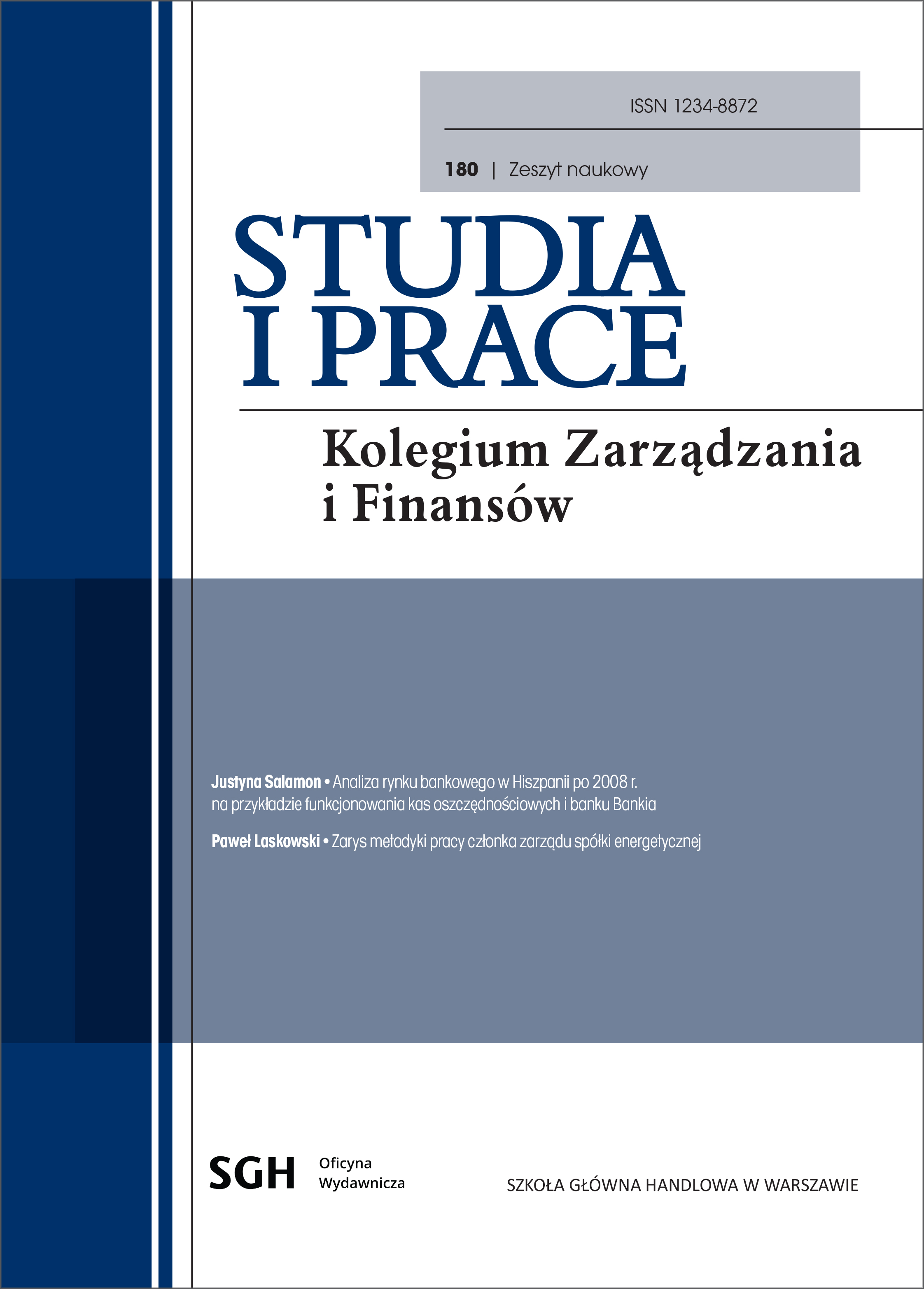Atrakcyjność inwestowania na rynku whisky inwestycyjnej
DOI:
https://doi.org/10.33119/SIP.2020.179.1Słowa kluczowe:
rynek finansowy, inwestycje alternatywne, rynek whisky inwestycyjnejAbstrakt
Inwestycje alternatywne zyskują na znaczeniu zwłaszcza w okresie perturbacji na rynkach finansowych. Ponadto z uwagi na niski współczynnik korelacji stóp zwrotu aktywów alternatywnych ze stopami zwrotu na rynku akcji czy też obligacji, mogą one być dodawane do portfeli inwestycyjnych w celu zwiększania efektywności tak skonstruowanych portfeli. Jednym z popularnych segmentów inwestycji alternatywnych, obok nieruchomości, dzieł sztuki, diamentów i win inwestycyjnych, powoli staje się rynek whisky inwestycyjnej. Porównanie stóp zwrotu w tym właśnie segmencie z innymi segmentami rynku finansowego jest utrudnione z uwagi mniejszą płynność rynku whisky niż chociażby akcji czy obligacji. Dlatego też zdecydowano się na zastosowanie trzech indeksów rynku whisky: Vintage 50, ICON 100 i Japanese ICON 100 w ujęciu miesięcznym. Uzyskane wyniki można zaliczyć do jednych z pierwszych na rynku polskim. W wielu przypadkach potwierdziły one inne badania z rynku świato¬wego dotyczące win inwestycyjnych, a z kolei w innych - zaprzeczyły im.
Downloads
Bibliografia
1. Adamska A. [2016], Alkohole jako przedmiot inwestycji alternatywnych, „Finanse, Rynki Finan¬sowe, Ubezpieczenia”, 4, 82, s. 571-579.
2. Anderson R. [1974], Paintings as an Investment, „Economic Inquiry”, 12, 1, s. 13-26.
3. Ashenfelter O., Ashmore D., Lalonde R. [1993], Wine Vintage Quality and the Weather: Bor- deaux, artykuł z konferencji Second International Society, Verona, Italy, 18-19.02.
4. Ashenfelter O., Storchmann K. [2006], Using a Hedonic Model of Solar Radiation to Assess the Economic Effect of Climate Change: The Case of Mosel Valley Vineyards, NBER Working Paper, no. 12380 (July).
5. Baumol W. [1986], Unnatural Value: Or Art Investment as Floating Grape Game, „American Economic Review”, 76, 2, s. 10-15.
6. Bentzen J., Leth-S0rensen S., Smith V. [2002], Prices of French ICON Wines and the Business Cycle: Empirical Evidence from Danish Wine Auctions, CIES Discussion Paper 0224.
7. Burton B., Jacobsen J. [1998], The Rate of Return on Investment in Wine, 1986-1996, Mimeo Wesleyan University, Middletown.
8. Burton B., Jacobsen J. [1999], Measuring Returns on Investments in Collectibles, „Journal of Economic Perspectives”, 13, s. 193-212.
9. Burton B., Jacobsen J. [2001], The Rate of Return on Investment in Wine, „Economic Inquiry”, 39, s. 337-350.
10. Byron R., Ashenfelter O. [1995], Predicting the Quality of an Unborn Grange, „Economic Record”, 71, 212, s. 40-53.
11. Cardell S., Kling J., Petry G. [1995], Stamp Returns and Economic Factors, „Southern Econo- mic Journal”, 62, 2, s. 411-427.
12. Combris P., Lecocq S., Visser M. [1997], Estimation of a Hedonic Price Equation for Bordeaux Wine: Does Quality Matter?, „Economic Journal”, 107, s. 390-402.
13. Di Vittorio A., Ginsburgh V. [1996], Pricing Red Wines of Medoc Vintages from 1949 to 1989 at Christies Auctions, „Journal de la Societe Statistique de Paris”, 137, s. 19-49.
14. Fase M. [1996], Purchase of Art: Consumption and Investment, „Economist”, 144, 4, s. 649-659.
15. Fogarty J. [2006], The Return to Australian Fine Wine, „European Review of Agricultural Economics”, 33, s. 542-561.
16. Frey B., Pommerehne W. [1989], Art Investment: An Empirical Inquiry, „Southern Economic Journal”, 56, 2, s. 396-409.
17. Goetzman W. [1995], The Information Efficiency of the Art Market, „Managerial Finance”, 21, 6, s. 25-34.
18. Goetzmann W. [1996], How Costly is the Fall from Fashion, Survivorship Bias in the Painting Market, Economics of Arts - Selected Essays, red. V. Ginsburgh, P. Menger, Elsevier, Amster¬dam, s. 71-84.
19. Haeger J., Storchmann K. [2006], Prices of American Pinot Noir Wines: Climate, Craftsman- ship, Critics, „Agricultural Economics”, 35, s. 67-78.
20. Ibbotson R., Brinson G. [1987], Investment Markets; Gaining the Performance Advantage, McGraw Hill, New York.
21. Jaeger E. [1981], To Save or Savor: The Rate of Return to Storing Wine, „Journal of Political Economy”, 89, 3, s. 584-592.
22. Jones G., Storchmann K. [2001], Wine Market Prices and Investment Under Uncertainty: An Econometric Model for Bordeaux Cru Classes, „Agricultural Economics”, 26, s. 114-133.
23. Kane A. [1984], Coins: Anatomy of a Fad Asset, „Journal of Portfolio Management”, 1, 2, s. 44-51.
24. Krasker W. [1979], The Rate of Return to String Wines, „Journal of Political Economy”, 87, 6, s. 1363-1367.
25. Masset P., Henderson C. [2009], Wine as an Alternative Asset Class, Working Paper.
26. Moroz D., Pecchioli B. [1999], Sholud You Invest in an Old Bottle of Whisky or in a Bottle of Old Whisky? A Hedonic Analysis of Vintage Single Malt Scotch Whisky Prices, „Journal of Wine Economics”, 14, 2, s. 145-163.
27. Parker R. [1985], Bordeaux: The Definitive Guide for the Wines Producers since 1961, Simon & Schuster, New York.
28. Pesando J. [1993], Art. As an Investment: The Market for Modern Prints, „American Econo- mic Review”, 83, 5, s. 1075-1089.
29. Sanning L., Shaffer S., Sharratt J. [2008], Bordeaux Wine as a Financial Investment, „Journal of Wine Economics”, 3, s. 61-81.
30. Sokolin W. [1987], Liquid Asset, Macmillan, New York.
31. Willis Towers Watson, World Gold Council.
Strony internetowe
1. https://stooq.pl, dostęp 3.03.2020.
2. https://www.rarewhisky101.com/indices, dostęp 22.03.2020.









